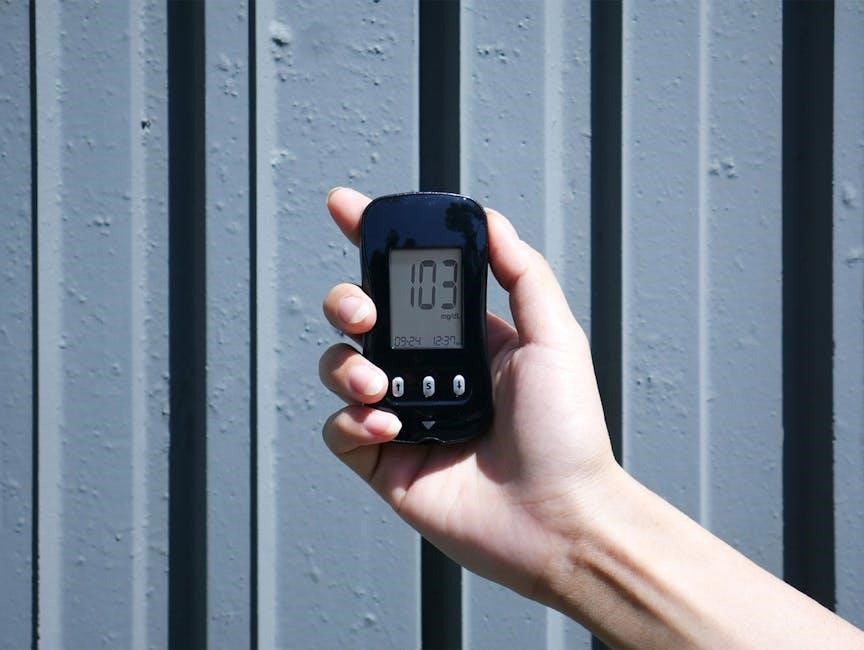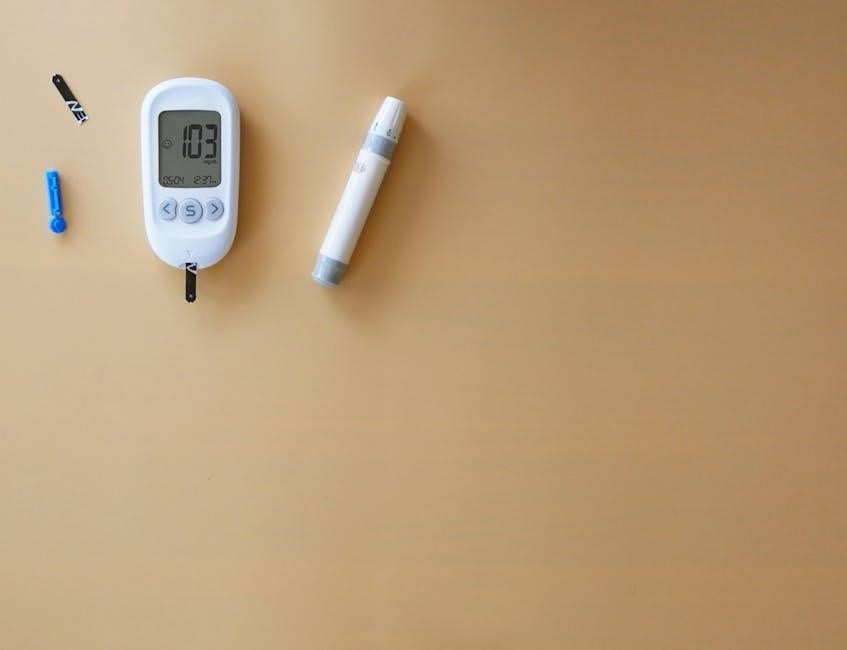The Blood Pressure Program offers a comprehensive approach to managing hypertension through targeted exercises and lifestyle adjustments․ This structured guide provides easy-to-follow strategies to stabilize blood pressure naturally, promoting overall cardiovascular health and well-being․
1․1 Overview of the Blood Pressure Program
The Blood Pressure Program is a comprehensive guide designed to help individuals manage hypertension through structured exercises and lifestyle modifications․ It combines aerobic activities, strength training, and flexibility exercises to promote cardiovascular health․ The program emphasizes the importance of diet, including the DASH diet, sodium reduction, and the role of potassium and calcium․ By incorporating physical activity and nutritional changes, participants can effectively lower blood pressure and improve overall well-being․ This approach is supported by scientific evidence and real-life success stories, making it a holistic solution for managing high blood pressure․
1․2 Importance of Managing Blood Pressure
Managing blood pressure is crucial for preventing serious health complications, such as heart disease, stroke, and kidney damage․ Uncontrolled hypertension can lead to arterial stiffness and cardiovascular dysfunction, significantly reducing quality of life․ Early intervention and consistent management are essential for maintaining optimal health․
By addressing high blood pressure through exercise and lifestyle changes, individuals can reduce their risk of developing these conditions․ This proactive approach not only improves physical well-being but also enhances mental health, fostering a healthier and more active lifestyle overall․

Benefits of Exercise for Blood Pressure
Regular exercise helps lower blood pressure, improves cardiovascular health, and enhances overall well-being․ It strengthens the heart, reduces stress, and promotes long-term blood pressure control․
2․1 Physical Health Benefits
Engaging in regular exercise through the Blood Pressure Program enhances cardiovascular health by strengthening the heart and improving blood flow․ It lowers resting blood pressure, increases vascular flexibility, and boosts overall physical stamina․ Exercise also aids in weight management, reducing the strain on the heart․ Additionally, it improves lung function and increases energy levels, contributing to better overall physical well-being․ These benefits work synergistically to support long-term blood pressure management and reduce the risk of cardiovascular diseases․
2․2 Mental Health Benefits
Regular exercise through the Blood Pressure Program significantly enhances mental health by reducing stress, anxiety, and depression․ Physical activity stimulates the release of endorphins, which improve mood and overall sense of well-being․ Engaging in exercises like yoga and tai chi fosters mental clarity and relaxation, helping to manage stress effectively․ The program also promotes a sense of accomplishment, boosting self-esteem and confidence․ These mental health benefits complement the physical improvements, creating a holistic approach to managing blood pressure and improving quality of life․
2․3 Long-Term Effects on Blood Pressure
Consistent participation in the Blood Pressure Program exercises leads to sustained reductions in blood pressure over time․ Regular aerobic and strength training activities strengthen the cardiovascular system, improving blood flow and reducing arterial stiffness․ The program’s focus on lifestyle changes, such as incorporating moderate-intensity exercises and stress management techniques, contributes to long-term blood pressure control․ Studies show that adhering to the program can lower systolic and diastolic readings by up to 10mmHg, significantly reducing the risk of heart disease and stroke․

Key Components of an Effective Exercise Program
An effective exercise program for blood pressure management includes aerobic exercises, strength training, and flexibility routines, promoting cardiovascular health and overall well-being through consistent practice․
3․1 Aerobic Exercises
Aerobic exercises are a cornerstone of the Blood Pressure Program, designed to enhance cardiovascular health and reduce hypertension․ Activities like brisk walking, cycling, and swimming are recommended, as they improve heart function and lower blood pressure over time․ These exercises are typically performed at moderate intensity, lasting 30-60 minutes per session, and should be done 3-5 times weekly for optimal results․ Regular aerobic activity strengthens the heart, improves circulation, and helps maintain consistent blood pressure levels, contributing to long-term health benefits․ Consistency is key to achieving and sustaining these positive effects․
3․2 Strength Training
Strength training is an essential component of the Blood Pressure Program, complementing aerobic exercises by building muscle and enhancing overall physical fitness․ It involves activities like weightlifting, resistance bands, or bodyweight exercises, performed 2-3 times weekly․ This form of exercise improves muscular endurance, boosts metabolism, and supports better circulation․ Over time, strength training can help lower resting blood pressure and improve overall cardiovascular health․ It is important to start with moderate intensity and gradually increase as fitness levels improve, ensuring safety and effectiveness for those managing hypertension․
3․3 Flexibility and Stretching Exercises
Flexibility and stretching exercises are integral to the Blood Pressure Program, enhancing range of motion and reducing muscle tension․ Activities like yoga and Tai Chi are commonly included, promoting relaxation and improving circulation․ These exercises help lower blood pressure by reducing arterial stiffness and enhancing overall vascular health․ Regular stretching also improves posture, reduces injury risk, and boosts physical comfort․ Incorporating these exercises into a daily routine supports long-term blood pressure management and contributes to a balanced, holistic approach to health․

Exercise Guidelines for Blood Pressure Management
Exercise guidelines emphasize regular aerobic and strength training, with warm-up routines to prevent sudden pressure spikes․ Avoid overexertion and stay hydrated to maintain balanced blood flow and nutrition․
4․1 Recommended Duration and Frequency
For effective blood pressure management, exercise should be performed 3-6 days per week․ Aerobic activities are recommended for 30-60 minutes, while strength training sessions should last 20-45 minutes, 2-3 times weekly․ Duration and frequency may vary based on individual fitness levels․ Starting with shorter sessions and gradually increasing intensity is advised․ Consistency is key to achieving long-term blood pressure reduction․ Always consult a healthcare provider before beginning any new exercise program to ensure safety and appropriateness for your specific condition․
4․2 Intensity Levels for Different Fitness Levels
Exercise intensity should be tailored to individual fitness levels to maximize benefits while ensuring safety․ For beginners, moderate-intensity activities like brisk walking or swimming are ideal․ Those with higher fitness levels can incorporate high-intensity interval training (HIIT) or strength training․ Aim for 50-70% of maximum heart rate for moderate intensity and 70-85% for vigorous workouts․ Always consult a healthcare provider to determine the appropriate intensity level, especially if managing hypertension․ Gradually increasing intensity over time helps achieve sustainable blood pressure reduction and overall cardiovascular health․
4․3 Warm-Up and Cool-Down Routines
A proper warm-up and cool-down are essential for safe and effective exercise․ Begin with 10-15 minutes of light cardio, such as brisk walking or cycling, to gradually increase heart rate and prepare muscles․ Incorporate dynamic stretches, like arm circles and leg swings, to improve flexibility and reduce injury risk․ After exercise, cool down with static stretches to relax muscles and lower blood pressure gradually․ Deep breathing exercises can also aid in reducing stress and promoting recovery․ Always prioritize these routines to ensure a smooth transition into and out of physical activity․

The Role of Diet in Blood Pressure Management
Diet plays a crucial role in managing blood pressure․ Adopting a balanced diet, such as the DASH diet, helps reduce sodium intake and increase potassium and calcium consumption, promoting overall heart health․
5․1 The DASH Diet
The DASH (Dietary Approaches to Stop Hypertension) Diet is a well-researched eating plan designed to help lower blood pressure․ It emphasizes fruits, vegetables, whole grains, lean proteins, and low-fat dairy while reducing sodium intake․ Studies show that adhering to the DASH Diet can lead to significant reductions in both systolic and diastolic blood pressure․ By focusing on nutrient-rich foods and limiting processed items, this diet promotes a holistic approach to managing hypertension and improving overall cardiovascular health․ It is widely recommended by healthcare professionals for its proven effectiveness in blood pressure management․
5․2 Importance of Sodium Reduction
Reducing sodium intake is crucial for managing blood pressure, as excess sodium can increase fluid retention and strain on blood vessels․ The DASH Diet emphasizes limiting sodium to help lower blood pressure naturally․ Studies show that reducing sodium intake can lead to significant reductions in both systolic and diastolic blood pressure․ Cutting back on processed foods and salty snacks is essential․ Even small reductions in sodium consumption can yield noticeable improvements in blood pressure levels, making it a key component of a hypertension management plan․
5․3 Role of Potassium and Calcium
Potassium and calcium play vital roles in blood pressure regulation․ Potassium helps balance sodium’s effects, reducing blood vessel tension, while calcium supports blood vessel function and heart health․ Incorporating potassium-rich foods like bananas, spinach, and oranges, along with calcium sources such as dairy and leafy greens, can significantly lower blood pressure․ These nutrients work synergistically with other dietary changes to enhance overall cardiovascular well-being and support the effectiveness of exercise programs aimed at managing hypertension․

Monitoring Progress and Adjustments
Regularly tracking blood pressure readings helps assess the effectiveness of the program․ Adjustments to exercise intensity and diet are made based on consistent progress and feedback․
6․1 Tracking Blood Pressure Readings
Regularly monitoring blood pressure is essential to evaluate the program’s effectiveness․ Use a home blood pressure monitor to track readings daily, ideally at the same time․ Consistency helps identify patterns and progress․ Record the data in a log or app for easy review․ This practice allows for timely adjustments to exercise intensity or diet․ Sharing the logs with healthcare providers ensures personalized feedback and program optimization․ Over time, consistent tracking motivates adherence and highlights the program’s impact on blood pressure management․
6․2 Adjusting Exercise Intensity
Exercise intensity should be tailored to individual fitness levels and blood pressure goals․ Start with moderate-intensity activities like brisk walking or swimming․ Gradually increase intensity as fitness improves, incorporating strength training or high-intensity interval training (HIIT) for enhanced benefits․ Monitoring progress and adjusting routines ensures sustained improvements in blood pressure․ Consult healthcare providers to personalize the program, balancing challenge and safety․ This adaptive approach optimizes results while minimizing risks, helping participants achieve long-term blood pressure management and improved cardiovascular health․
6․3 Incorporating Feedback from Healthcare Providers
Regular communication with healthcare providers is crucial for tailoring the exercise program to individual needs․ They assess progress, adjust routines, and ensure safety․ Feedback helps set realistic goals, address challenges, and celebrate achievements․ Providers may modify intensity or duration based on blood pressure trends․ This collaborative approach ensures the program remains effective and aligned with health objectives, fostering a supportive environment for long-term success in managing blood pressure․

Common Exercises for Blood Pressure Management
Brisk walking, swimming, and yoga are effective exercises for lowering blood pressure․ These activities promote cardiovascular health and can be adapted to different fitness levels․
7․1 Brisk Walking
Brisk walking is a key component of the Blood Pressure Program, offering significant cardiovascular benefits․ It is an accessible, low-impact exercise that can be performed almost anywhere․ Regular brisk walking helps lower blood pressure by improving heart health and enhancing blood flow․ Aim for at least 30 minutes daily, adjusting intensity based on fitness levels․ This simple yet effective activity is ideal for those seeking to manage hypertension naturally and improve overall well-being․ Incorporating brisk walking into your routine can lead to noticeable improvements in blood pressure over time․
7․2 Swimming
Swimming is an excellent, low-impact exercise for managing blood pressure․ It engages multiple muscle groups, improving cardiovascular health without excessive strain on joints․ Regular swimming sessions can help lower blood pressure by enhancing blood flow and strengthening the heart․ Additionally, swimming reduces stress and promotes relaxation, further supporting blood pressure control․ For those with hypertension, incorporating swimming into their routine can lead to significant improvements in overall health and well-being․ It is a versatile and effective option for individuals of all fitness levels․
7․3 Tai Chi and Yoga
Tai Chi and Yoga are low-impact exercises that combine slow movements, deep breathing, and meditation, making them ideal for managing blood pressure․ These practices improve flexibility, balance, and circulation while reducing stress and anxiety․ Tai Chi, in particular, has been shown to lower blood pressure in hypertensive individuals by promoting relaxation and improving vascular function․ Yoga also enhances cardiovascular health by reducing arterial stiffness and promoting better blood flow․ Both practices are gentle on the joints, making them accessible to individuals with mobility challenges, and they complement other exercises in the Blood Pressure Program․

Safety Precautions for Exercise Programs
Consult a healthcare provider before starting any exercise program, especially with hypertension․ Avoid overexertion, stay hydrated, and ensure proper nutrition to maintain safety and effectiveness․
8․1 Consulting a Doctor Before Starting
Before beginning any exercise program, especially for blood pressure management, consulting a healthcare provider is crucial․ A doctor will assess your medical history, current health status, and any potential risks․ This ensures the program is safe and tailored to your needs․ For individuals with hypertension, a physician’s clearance is essential to avoid complications․ They may recommend specific exercises or modifications based on your condition․ This step is vital for creating a personalized and effective plan while minimizing health risks․ Regular check-ups can also monitor progress and safety throughout the program․
8․2 Avoiding Overexertion
Avoiding overexertion is critical when starting an exercise program, especially for those managing blood pressure․ Overexertion can lead to dizziness, chest pain, or shortness of breath, which may worsen hypertension․ Begin with moderate-intensity exercises and gradually increase intensity as fitness improves․ Listening to your body and incorporating regular rest periods is essential․ If symptoms like lightheadedness occur, stop the activity immediately and consult a healthcare provider․ Balancing effort and recovery ensures a safe and effective exercise routine tailored to individual health needs and goals․
8․3 Managing Dehydration and Nutrition
Proper hydration is vital for maintaining healthy blood pressure levels․ Dehydration can lead to decreased blood volume, potentially causing dizziness or fainting․ Drinking water regularly before, during, and after exercise is recommended; Additionally, nutrition plays a significant role in blood pressure management․ A balanced diet rich in fruits, vegetables, and whole grains, along with reduced sodium intake, supports overall cardiovascular health․ Avoiding excessive caffeine and alcohol is also advised․ Combining these practices with regular exercise helps maintain stability and promotes long-term blood pressure control, enhancing the effectiveness of the program․

The Impact of Stress on Blood Pressure
Stress significantly impacts blood pressure by triggering hormonal responses, increasing heart rate, and causing vasoconstriction․ Chronic stress can lead to hypertension․ Relaxation techniques and mind-body exercises help mitigate these effects․
9․1 Stress Management Techniques
Stress management techniques, such as deep breathing, progressive muscle relaxation, and mindfulness, help reduce the physiological effects of stress․ Regular practice of these methods lowers cortisol levels, improves mood, and stabilizes blood pressure․ Incorporating exercises like Tai Chi and yoga further enhances relaxation and reduces stress-related hypertension․ These techniques, when combined with physical activity, create a holistic approach to managing stress and controlling blood pressure effectively․ Consistent practice is key to achieving long-term benefits for both mental and cardiovascular health․
9․2 Mind-Body Exercises
Mind-body exercises, such as yoga and Tai Chi, combine physical movement with mental focus to promote relaxation and reduce stress․ These practices improve balance, flexibility, and mental clarity while lowering blood pressure․ By incorporating deep breathing and meditation, they help reduce cortisol levels, enhancing overall well-being․ Regular practice of these exercises creates a calming effect on the body, contributing to better blood pressure management and emotional stability․ They are particularly effective for individuals seeking holistic approaches to health and stress reduction․
9․3 Sleep and Recovery
Sufficient sleep and recovery are crucial for maintaining healthy blood pressure levels․ Lack of sleep can disrupt hormones that regulate stress, leading to increased blood pressure․ Aim for 7-8 hours of quality sleep nightly to support cardiovascular health․ Establish a consistent bedtime routine, avoid caffeine and electronics before bed, and create a relaxing environment․ Prioritizing recovery allows the body to repair and recharge, contributing to overall well-being and blood pressure stability․ Adequate rest complements exercise and diet, forming a holistic approach to managing hypertension effectively․

Case Studies and Success Stories
Real-life examples highlight participants who significantly reduced blood pressure through consistent exercise and lifestyle changes, showcasing the program’s effectiveness in improving overall health and well-being․
10․1 Real-Life Examples of Blood Pressure Improvement
Participants in the Blood Pressure Program reported significant reductions in blood pressure, with some achieving a 10mmHg decrease in both systolic and diastolic readings․ For instance, a 60-year-old male reduced his blood pressure from 150/95 mmHg to 130/85 mmHg after following the program’s structured exercise plan․ These real-life examples highlight how consistent implementation of the program’s strategies, including brisk walking, swimming, and yoga, can lead to meaningful improvements in blood pressure without medication, showcasing the program’s effectiveness and inspiring others to adopt its principles for better health outcomes․
10․2 Testimonials from Program Participants
Participants in the Blood Pressure Program have shared inspiring testimonials about their journeys․ Many reported significant improvements in their blood pressure levels, with one participant noting a reduction from 150/95 mmHg to 130/85 mmHg after just a few weeks․ “The exercises are simple yet effective,” said another participant, who emphasized how the program helped them regain control over their health․ These firsthand experiences highlight the program’s practicality and its ability to empower individuals to achieve lasting results without relying solely on medication․
10․3 Scientific Evidence Supporting the Program
Research underscores the effectiveness of the Blood Pressure Program, with studies demonstrating that regular aerobic and strength training can lower systolic and diastolic blood pressure by up to 10mmHg․ A 12-week HIIT program showed improvements in cardiac function and reduced resting heart rates․ Additionally, the DASH diet, a key component of the program, has been proven to significantly reduce hypertension․ These findings, supported by clinical trials, validate the program’s holistic approach to managing blood pressure and enhancing overall cardiovascular health․
11․1 Encouragement to Stick to the Program
Persistence is key to achieving lasting blood pressure control․ The program’s exercises and lifestyle changes, supported by scientific evidence, have helped many individuals reduce hypertension․ Real-life success stories and testimonials highlight the program’s effectiveness․ Staying committed ensures long-term benefits, such as improved cardiovascular health and reduced risk of complications․ Remember, consistency breeds results, and the support of a community can motivate you to stay on track․Celebrate small milestones and embrace the journey toward a healthier, happier life with the Blood Pressure Program․
11․2 Long-Term Benefits of Consistent Exercise
Regular exercise within the Blood Pressure Program fosters significant long-term health improvements․ Sustained physical activity helps maintain stable blood pressure levels, enhances cardiovascular function, and reduces the risk of heart disease․ Over time, participants often experience improved energy levels, stronger muscles, and better overall well-being․ Consistency strengthens the body’s ability to manage stress and maintain a healthy weight, further supporting blood pressure control․ These benefits create a foundation for a longer, healthier life, making exercise a vital component of hypertension management and prevention․
11․3 Importance of Community Support
Community support plays a crucial role in the success of the Blood Pressure Program․ Sharing experiences and challenges with others fosters motivation and accountability․ Group exercises and discussions create a sense of belonging, encouraging participants to stay committed to their health goals․ Additionally, peer encouragement and shared achievements celebrate progress, reinforcing the importance of collective effort․ This supportive environment helps individuals maintain consistency and adhere to the program, ultimately contributing to better blood pressure management and overall well-being․

